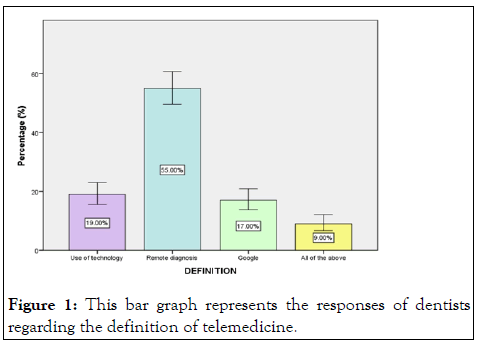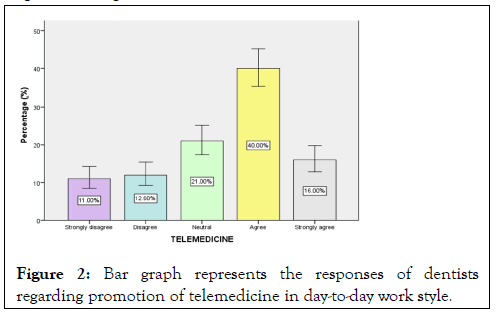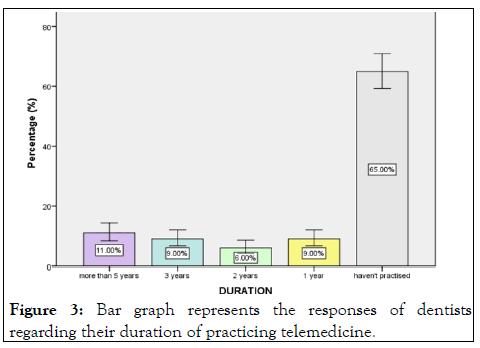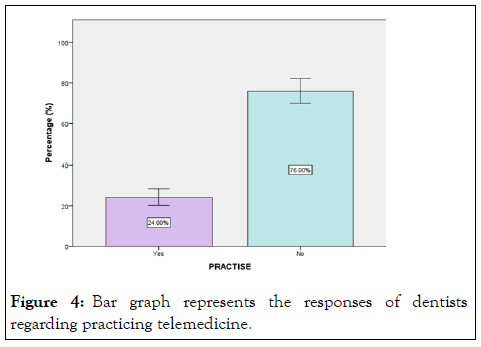Internal Medicine: Open Access
Open Access
ISSN: 2165-8048
ISSN: 2165-8048
Research Article - (2022)
Aim: The aim of the study is to assess the knowledge, attitude and practices regarding telemedicine among dentists in Chennai.
Introduction: Telemedicine can be broadly defined as the use of telecommunications technologies to provide medical information and services. Telemedicine allows health care professionals to evaluate, diagnose and treat patients at a distance using telecommunications technology. Interest in the field has increased dramatically in the 1990s. They are the new and advanced technology to create a web of communication that can help us in difficult situations; they apply to the medical field too.
Methods: This cross-sectional study was conducted among 100 dentists in chennai, using a questionnaire consisting of 15 close-ended questions. Questionnaire survey was conducted through social media. The obtained results were analyzed in SPSS Software. Results obtained were expressed in frequencies and percentages; mean and standard deviation. Pearson’s chi square test was used to analyze the association between the categorical variables.
Results: 55% of the respondents are aware of the definition of telemedicine. 76% of the respondents chose telemedicine because telemedicine is more convenient for them to apply. From the obtained results, 76% of the dentists haven't practiced telemedicine. On gender comparison, it was seen that males (14%) practiced telemedicine more than that of females (10%).
Conclusion: From the study we can conclude that the dentists have an adequate knowledge of telemedicine, and positive attitude towards telemedicine but they seldom practice telemedicine. Male dentists practice telemedicine more when compared to that of female dentists. People are aware of telemedicine, but they don't practice because of the lack of awareness over the patients. They rarely get an online case to attend, hence they discontinued. The build of trust and bond between the dentist and patient determines the case handling and length. But the inability to get cases is purely the lack of awareness of the patients.
Telemedicine; Questionnaire; Dentistry; Innovative technique
Telemedicine can be broadly defined as the use of telecommunications technologies to provide medical information and services. Telemedicine allows health care professionals to evaluate, diagnose and treat patients at a distance using telecommunications technology. Interest in the field has increased dramatically in the 1990s.Telemedicine is a medium that encompasses any medical activity involving an element of distance. Basically, it is a doctor-patient interaction involving telecommunication [1]. A few years ago, the term telemedicine began to be supplanted by the term telehealth, which was thought to be more “politically correct,” but in the past years, this too has been overtaken by even more fashionable terms such as online health and e-health. As telecommunication technology has advanced and costs have declined over the past decade, there has been a steady growth in telemedicine. Telemedicine is conceived of as an integrated system of healthcare delivery that employs telecommunications and computer technology as a substitute for face-to-face contact between provider and client. It has the potential for ameliorating seemingly intractable problems in healthcare such as limited access to care among segments in the population, especially the geographically disadvantaged uneven quality of care, and cost inflation [2]. The tele-communication is a bridge communication for the whole world. And they serve as a medium to connect people all over the world [3].
They are the new and advanced technology to create a web of communication that can help us in difficult situations. They apply to the medical field too. Patients who have difficulty, but are unable to go to the doctor, people who have problems within them but cannot go to doctor because of reserved society or heaving situations like pandemic, telecommunication can play a major role. Telecommunication is a direct connection of the patient and the doctor through a global network [4]. Telecommunication works on three principles, they are real time telemedicine, remote patient monitoring and store and forward telemedicine [3]. Real time telecommunication is the direct communication with the patient and their guardian, and collection of chief complaints, history of complaint, family history and medication history. The chief complaint is usually taken from the patient and based on the way they express it. The family history is collected both from the patient and guardian, and assesses all to check for the primary diagnosis [3]. Real time telecommunication can be taken in appointments and they are the process of interacting with the patient. They serve to connect the doctor and the patient and maintain the bond between them. This will build trust in the doctor and this makes the patient very close to the doctor. The second principle is remote patient monitoring, it can be defined as a technology to enable monitoring of patients outside of conventional clinical settings, such as in the home or in a remote area, which may increase access to care and decrease healthcare delivery costs. This is a process purely done by the patient; this process requires little common equipment which should be present in household settings. Common equipment like thermometer and BP level analyzer, sometimes pulse level and pulse oximeter [4]. The patient and guardian should cooperate with each other and should record all this information over the chart provided to them. These are the vital analyses and they help in the diagnosis [5]. And the last principle is store and forward, this is the process of saving the complete history of the patient and storing in the cloud service. The cloud service is the common access provided to all the doctors who are involved in telemedicine. They are the reserve of all the patient details auto update each and every hour. Once the ID of the patient is entered, the whole history is provided to the attending doctor [6].
Telemedicine is most accepted in developed countries because most of the people are aware of telemedicine, they are pretty cheap when compared to the general physician, the work of the doctor is little less because they schedule the appointments when they are free. This kind of awareness is lacking in developing countries, the unavailability of network connection, proper vital analysis instruments, etc. [7]. Hence developing countries are unable to support telemedicine [3]. Telemedicine is not applicable for severe complaints like major involvement of heart, lungs and brain, but they give an immediate remedy for all that. Telemedicine usually attends patients who have minor problems and counseling sessions. One of the best uses of telemedicine is the auto record history for each and every patient on their ID. Hospitals keep track of their patients, but there is a high possibility that patients approach various hospitals for the best treatment. So, the interlinking of all these records is not available, which is provided in case of telemedicine [8].
Telemedicine entered the market of India over the recent years; this is not well accepted by the people but patients who are aware of the technology initiated to approach this. Telemedicine is used in some major hospitals to collect the primary data from the patients, followed by calling the patient over the hospital for the treatment. Our team has extensive knowledge and research experience that has translated into high quality publications. The aim of this research is to analyze the Knowledge, attitude and practices regarding telemedicine among dentists in chennai.
This cross-sectional study was conducted in 2021 among 100 dentists of chennai. A questionnaire consisting of 15 questions to assess the knowledge, attitude and practices regarding telemedicine among dentists were prepared and circulated among the dentists using Google forms. The dentists were requested to answer; data was collected and then tabulated. Later data was exported to SPSS software. Frequency, percentages were ascertained and association with gender was done using chi square analysis with p<0.05 as statistically significant. Bar graphs were used to depict the results obtained [9].
X axis represents the various responses and Y axis represents the percentage of respondents. Responses follow: Use of technology-19%, remote diagnosis-55%, usage of google-17% and the entire above-9% (Figure 1).

Figure 1: This bar graph represents the responses of dentists regarding the definition of telemedicine.
X axis represents the various responses and Y axis represents the percentage of respondents. Responses whereas follows: Strongly disagree-11%, agree-12%, neutral-21%, agree-40% and strongly agree-16% (Figure 2).

Figure 2: Bar graph represents the responses of dentists regarding promotion of telemedicine in day-to-day work style.
X axis represents the various responses and Y axis represents the percentage of respondents. Responses whereas follows-more than 3 years-11%, 3 years-9%, 2 years-6%, 1 year-9% and not practicing 65% (Figure 3).

Figure 3: Bar graph represents the responses of dentists regarding their duration of practicing telemedicine.
X axis represents the various responses and Y axis represents the percentage of respondents. Responses whereas follows: Yes-23% and no-77% (Figure 4).

Figure 4: Bar graph represents the responses of dentists regarding practicing telemedicine.
Depending on your healthcare provider’s setup, doctors can use telemedicine for your consultation. The consultation required basic vital analytic instruments and specific diagnostic instruments; hence they refer you to the nearest doctor. The doctor can forward diagnostic images such as X-rays and your medical history to the telemedicine doctor for them to review. The telemedicine doctor may have enough information to make a diagnosis and even create the appropriate treatment plan. If not, they can contact you or your doctor for more information. Together you all can decide on the best treatment plan [10].
Some healthcare professionals have remote patient monitoring systems set up. These remote systems are constantly collecting and sending data to other healthcare agencies for interpretation. This is an important step in telemedicine because even if you are homebound, you can easily get your latest health information over to your doctor. A nurse can come, set up all the equipment in your home, conduct the needed tests, and transmit the data to the doctor before the close of business. Telemedicine is great for doctors and people seeking medical treatment when it comes to treatment and diagnosis. It can also be a great support system. Online peer discussion groups not only provide helpful information, but also, more importantly, support. Meeting other people going through the same thing as you can help you feel less alone. It can be encouraging and offer peace of mind [11].
This type of telemedicine technology is even more important for healthcare officials volunteering in distant places or currently serving in the military. Medical facilities are not always nearby. Receiving treatment or information can be almost impossible. Telemedicine can help save a life.
From our study we can say that dentists are aware of the definition of telemedicine, about 55% of the respondents opted for remote diagnosis. As they define it as telemedicine is the remote diagnosis by the doctor over the patient through telecommunication. The dentists of chennai are aware of the definition of telemedicine. From our study, we can say that 21% of the respondents strongly agree that telemedicine improves their day-to-day lifestyle. 40% of the respondents agree that telemedicine improves their day-to-day lifestyle. Hence, we can say that most dentists say that telemedicine paves a way to promote their lifestyle. The usage of telecommunication over the diagnosis is a new method followed over India; previously people used that to collect history and to collect the complaints from the patient [12].
Our study results state that the reason for practicing telemedicine, most of the dentists say that telemedicine is convenient for approaching the patient and diagnosing them. They determine the severity of the case and schedule them accordingly. The severity of the case may vary from high risk to low risk, they analyse the case online and they would prepare for it accordingly [13]. The second favourable reason is provision of immediate remedy. The people who are in need of immediate action but they are unable to travel or they live in a remote area, the provision of immediate remedy or lifesaving remedy is needed. In our study, the responses for the duration of dentists over telemedicine, 65% of the dentists don't practice telemedicine, and among the people who practice telemedicine, 11% of the dentists practice telemedicine more than 3 years, 9% of the dentists practice telemedicine for 3 years, and 15% of the dentists practice telemedicine less than 2 years. So we can say that very limited people practice telemedicine, but in recent years there is improvement in the practice of telemedicine [14].
Our study results state that of dentists who practice telemedicine, from the graph we can see that only 23% of the dentists practice telemedicine. People are aware of telemedicine, but they don't practice because of the lack of awareness over the patients. They rarely get an online case to attend, hence they discontinued. The build of trust and bond between the dentist and patient determines the case handling and length. But the inability to get cases is purely the lack of awareness of the patients.
In our study, the gender comparison of dentists on telemedicine was done, and it is observed from the graph that male dentists practice telemedicine more when compared to the female dentists. In our study, 14% of male dentists practice telemedicine whereas 10% of female dentists practice telemedicine [15]. According to our study, 29% of females are aware of the definition of telemedicine compared to males with 26%. Also, males predominantly agree that telemedicine works in day-to day life with 6% of males and 5% of females practicing telemedicine for over three years. In our study, 38% of males and 38% of females chose to practice telemedicine because of their convenience. Hence it is clear that males practice telemedicine more than that of females. The limitations of this study include the low demographic data. The involvement of a large number of dentists from a vast area would give a greater diversity.
From the study we can conclude that the dentists have an adequate knowledge of telemedicine, and positive attitude towards telemedicine but they seldom practice telemedicine. Male dentists practice telemedicine more when compared to that of female dentists. People are aware of telemedicine, but they don't practice because of the lack of awareness over the patients. They rarely get an online case to attend, hence they discontinued. The build of trust and bond between the dentist and patient determines the case handling and length. But the inability to get cases is purely the lack of awareness of the patients.
The authors would like to acknowledge the help and support rendered by the Department of oral surgery, Saveetha Dental College and Hospitals, Saveetha Institute of Medical and Technical Sciences, Saveetha University, Chennai.
The authors would like to acknowledge the help and support rendered by the Department of oral surgery, Saveetha Dental College and Hospitals, Saveetha Institute of Medical and Technical Sciences, Saveetha University, Chennai.
[Cross Ref] [Google Scholar] [PubMed]
[Cross Ref] [Google Scholar] [PubMed]
[Cross Ref] [Google Scholar] [PubMed]
[Cross Ref] [Google Scholar] [PubMed]
[Cross Ref] [Google Scholar] [PubMed]
[Cross Ref] [Google Scholar] [PubMed]
[Cross Ref] [Google Scholar] [PubMed]
[Cross Ref] [Google Scholar] [PubMed]
[Cross Ref] [Google Scholar] [PubMed]
[Cross Ref] [Google Scholar] [PubMed]
[Cross Ref] [Google Scholar] [PubMed]
[Cross Ref] [Google Scholar] [PubMed]
[Google Scholar] [PubMed]
Citation: Aslam MA, Akash N, Kumar S (2022) Knowledge, Attitude and Practices Regarding Telemedicine among Dental Practitioners. Intern Med. S10:002.
Received: 08-Feb-2022, Manuscript No. IME-21-004; Editor assigned: 10-Feb-2022, Pre QC No. IME-21-004 (PQ); Reviewed: 24-Feb-2022, QC No. IME-21-004; Revised: 28-Feb-2022, Manuscript No. IME-21-004 (R); Published: 06-Mar-2022 , DOI: 10.35248/2165-8048.22.12.002
Copyright: © 2022 Aslam MA, et al. This is an open-access article distributed under the terms of the Creative Commons Attribution License, which permits unrestricted use, distribution, and reproduction in any medium, provided the original author and source are credited.
Sources of funding : NO